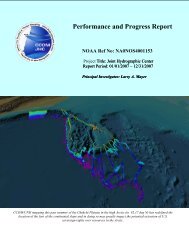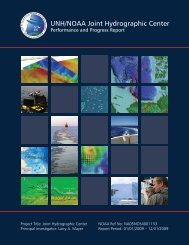Performance and Progress Report - John Doe FIX: put in the authors ...
Performance and Progress Report - John Doe FIX: put in the authors ...
Performance and Progress Report - John Doe FIX: put in the authors ...
You also want an ePaper? Increase the reach of your titles
YUMPU automatically turns print PDFs into web optimized ePapers that Google loves.
never before been achievable <strong>in</strong> hydrographic data. The result is “ga<strong>in</strong>ed efficiency,<br />
reduced costs, improved data quality <strong>and</strong> consistency, <strong>and</strong> <strong>the</strong> ability to <strong>put</strong> products <strong>in</strong><br />
<strong>the</strong> h<strong>and</strong>s of our customers faster.” (Capt. Roger Parsons, Director of NOAA’s Office of<br />
Coast Survey).<br />
The acceptance of CUBE <strong>and</strong> <strong>the</strong> Navigation Surface has required a paradigm shift for<br />
<strong>the</strong> hydrographic community -- from deal<strong>in</strong>g with <strong>in</strong>dividual sound<strong>in</strong>gs (reasonable <strong>in</strong> a<br />
world of lead l<strong>in</strong>e <strong>and</strong> s<strong>in</strong>gle-beam sonar measurements) to <strong>the</strong> acceptance of gridded<br />
depth estimates as a start<strong>in</strong>g po<strong>in</strong>t for hydrographic products. The research needed to<br />
support this paradigm shift has been a focus of <strong>the</strong> Center s<strong>in</strong>ce its <strong>in</strong>ception; to now see<br />
it be<strong>in</strong>g universally accepted is truly reward<strong>in</strong>g. It is also <strong>in</strong>dicative of <strong>the</strong> role that <strong>the</strong><br />
Center has been play<strong>in</strong>g <strong>and</strong> will cont<strong>in</strong>ue to play <strong>in</strong> establish<strong>in</strong>g new directions <strong>in</strong><br />
hydrography <strong>and</strong> ocean mapp<strong>in</strong>g.<br />
Statements from senior NOAA managers <strong>and</strong> <strong>the</strong> actions of o<strong>the</strong>r hydrographic agencies<br />
<strong>and</strong> <strong>the</strong> <strong>in</strong>dustrial sector provide clear evidence that we are mak<strong>in</strong>g a real contribution to<br />
NOAA <strong>and</strong> <strong>the</strong> <strong>in</strong>ternational community. While we believe we have met <strong>the</strong> <strong>in</strong>itial goals<br />
we set, we will certa<strong>in</strong>ly not stop <strong>the</strong>re. Both CUBE <strong>and</strong> <strong>the</strong> Navigation Surface offer a<br />
framework upon which new <strong>in</strong>novations are be<strong>in</strong>g built <strong>and</strong> new efficiencies ga<strong>in</strong>ed.<br />
Additionally, <strong>the</strong>y provide a start<strong>in</strong>g po<strong>in</strong>t for <strong>the</strong> delivery of a range of non-hydrographic<br />
mapp<strong>in</strong>g products that set <strong>the</strong> scene for future research efforts.<br />
This past year we have extended <strong>the</strong> usefulness of <strong>the</strong> CUBE through <strong>the</strong> development of<br />
ways to apply this process<strong>in</strong>g approach to <strong>the</strong> <strong>in</strong>itial calibration tests performed for<br />
multibeam sonar systems when deployed at sea (<strong>the</strong> “patch test”). When CUBE has been<br />
applied to patch tests, <strong>the</strong> overall uncerta<strong>in</strong>ty of <strong>the</strong> survey data have been reduced by at<br />
least 5 percent. In ano<strong>the</strong>r effort to improve survey accuracy we have developed<br />
software that takes advantage of a new tim<strong>in</strong>g protocol (IEEE-1588) <strong>and</strong> allows <strong>the</strong><br />
components of a sonar system to be synchronized with<strong>in</strong> an absolute time accuracy of<br />
approximately 100 nanoseconds. This level of tim<strong>in</strong>g will greatly enhance <strong>the</strong> accuracy<br />
of hydrographic surveys <strong>and</strong> is already be<strong>in</strong>g implemented by our <strong>in</strong>dustrial partners.<br />
Inherent <strong>in</strong> <strong>the</strong> Navigation Surface concept is our long-held belief that <strong>the</strong> “products” of<br />
hydrographic data process<strong>in</strong>g can also serve a variety of applications <strong>and</strong> constituencies<br />
beyond hydrography. Ano<strong>the</strong>r long-held tenet of <strong>the</strong> Center is that <strong>the</strong> st<strong>and</strong>ard<br />
navigation charts produced by <strong>the</strong> world’s hydrographic authorities do not do justice to<br />
<strong>the</strong> <strong>in</strong>formation content of high-resolution multibeam <strong>and</strong> sidescan sonar data. We also<br />
believe that <strong>the</strong> mode of delivery of <strong>the</strong>se products will <strong>in</strong>evitably be electronic — thus<br />
our <strong>in</strong>itiation of “The Electronic Chart of <strong>the</strong> Future” project. This effort draws upon our<br />
visualization team, our signal <strong>and</strong> image processors, <strong>and</strong> our hydrographers <strong>and</strong> mar<strong>in</strong>ers.<br />
In do<strong>in</strong>g so, it epitomizes <strong>the</strong> strength of our Center –- <strong>the</strong> ability to br<strong>in</strong>g toge<strong>the</strong>r<br />
talented people with a range of skills to focus on problems that are important to NOAA<br />
<strong>and</strong> <strong>the</strong> nation. The Electronic Chart of <strong>the</strong> Future project is <strong>in</strong> its early stages with<br />
prototypes be<strong>in</strong>g built <strong>and</strong> tested. An early accomplishment has been <strong>the</strong> demonstration<br />
of <strong>the</strong> ability to send chart-relevant data via <strong>the</strong> Automated Information System (AIS)<br />
JHC <strong>Performance</strong> <strong>Report</strong> 3 30 January 2007




